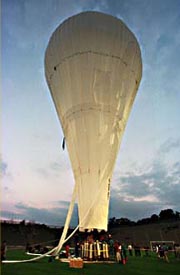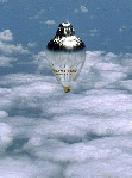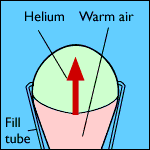nh1476@bristol.ac.uk
School of Chemistry
University of Bristol
Lighter than air
|
Chemists Montgolfier brothers Gas balloons Airships and blimps Modern hot air balloons Rozier balloons Special shapes |
Rozier balloons
Circumnavigation of the Earth by hot air balloon remained an elusive goal for many years. Man reached the moon before this feat was achieved in 2003 by Steve Fossett who completed the task in 14 days and 20 hours, over two centuries after a balloon first took to the skies.
The craft used for this epic voyage was a hybrid of a hot air balloon and a gas filled balloon. This type of balloon is known as a Rozier after one of the first people to fly in a hot air balloon. It has a double skin, which is filled with hot air but also contains a helium balloon. The advantage of this type of balloon is that, overnight, as the air in the balloon gets cooler, the hot air burners can be switched on to slow the descent of the balloon. A tiny quantity of propane is required to heat the helium, relative to a standard air balloon.

|

|

|
| http://myhero.com/hero.asp?hero=stevefossett http://www.didyouknow.cd/aroundtheworld/balloons.htm http://news.bbc.co.uk/1/hi/special_report/1998/balloon_race/48465.stm |
||
At the start of the voyage, the sphere is only half filled with helium. During the ascent, decreased pressure and rising gas temperature from the heat of the sun, cause the helium to expand. The system automatically vents helium gas if the pressure becomes excessive.
Rozier balloons depend on the heat of the sun by day and the heat of propane by night. If things went wrong and the balloon vented too much helium, the craft could function as a classic hot air balloon. Furthermore, the balloon fabric could function as a giant parachute, keeping the descent rate below 5 metres per second.